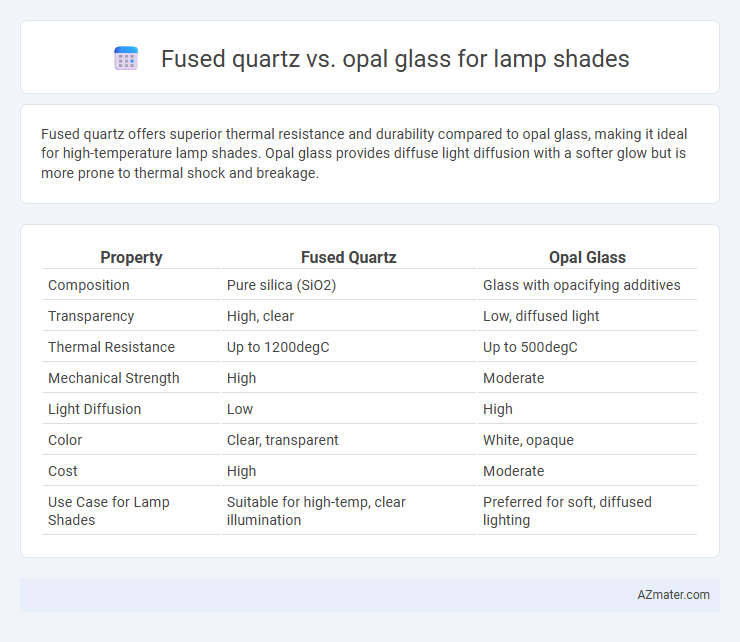Fused quartz offers superior thermal resistance and durability compared to opal glass, making it ideal for high-temperature lamp shades. Opal glass provides diffuse light diffusion with a softer glow but is more prone to thermal shock and breakage.
Table of Comparison
| Property | Fused Quartz | Opal Glass |
|---|---|---|
| Composition | Pure silica (SiO2) | Glass with opacifying additives |
| Transparency | High, clear | Low, diffused light |
| Thermal Resistance | Up to 1200degC | Up to 500degC |
| Mechanical Strength | High | Moderate |
| Light Diffusion | Low | High |
| Color | Clear, transparent | White, opaque |
| Cost | High | Moderate |
| Use Case for Lamp Shades | Suitable for high-temp, clear illumination | Preferred for soft, diffused lighting |
Introduction to Lamp Shade Materials
Fused quartz and opal glass are popular materials used in lamp shades due to their unique thermal and optical properties. Fused quartz offers exceptional heat resistance and durability, making it suitable for high-temperature lighting applications, while opal glass provides diffused light with a soft, aesthetic glow, enhancing ambiance. Choosing between fused quartz and opal glass depends on factors such as heat tolerance, light diffusion quality, and design preferences in lamp shade manufacturing.
What is Fused Quartz?
Fused quartz is a high-purity silica glass known for its exceptional thermal stability, low thermal expansion, and excellent optical clarity, making it ideal for lamp shades exposed to high temperatures. Unlike opal glass, which contains additives that diffuse light and offer a frosted appearance, fused quartz remains transparent and withstands rapid temperature changes without cracking. Its durability and resistance to heat make fused quartz a superior choice for lamp shades requiring both aesthetic clarity and long-term performance.
Understanding Opal Glass
Opal glass is a high-quality material known for its excellent light diffusion and soft, uniform glow, making it a popular choice for lamp shades. Unlike fused quartz, which is highly transparent and offers superior heat resistance, opal glass contains microscopic air bubbles or opacifiers that create a milky, translucent appearance ideal for ambient lighting. Opal glass also provides good thermal stability and durability while enhancing aesthetic appeal through its smooth, frosted finish.
Light Transmission: Fused Quartz vs Opal Glass
Fused quartz offers superior light transmission, typically around 90% or higher, allowing for a clearer, brighter illumination compared to opal glass, which usually transmits 40-70% of light due to its milky, diffusive properties. This makes fused quartz ideal for applications requiring maximum brightness and clarity, while opal glass provides softer, more diffuse lighting to reduce glare. The choice between fused quartz and opal glass for lamp shades depends largely on the desired light quality and intensity, with fused quartz enabling sharper, more vibrant light output.
Durability and Heat Resistance Comparison
Fused quartz offers superior heat resistance, withstanding temperatures up to 1,150degC, making it ideal for lamp shades exposed to intense heat. Opal glass, while aesthetically pleasing, has a lower heat tolerance around 500degC and is more prone to thermal shock and cracking under rapid temperature changes. Durability-wise, fused quartz excels due to its robust chemical stability and mechanical strength, ensuring longer lifespan and reliability in demanding lighting applications.
Aesthetic and Design Differences
Fused quartz offers a sleek, transparent appearance with high clarity and minimal color distortion, ideal for modern, minimalist lamp shades requiring precise light diffusion. Opal glass provides a soft, milky white finish that diffuses light evenly, creating a warm, ambient glow suited for classic and cozy interior designs. The choice between fused quartz and opal glass depends on the desired visual effect and light quality, with quartz emphasizing sharpness and clarity, while opal glass prioritizes softness and warmth.
Cost Analysis: Fused Quartz vs Opal Glass
Fused quartz lamp shades incur higher manufacturing costs due to raw material purity and energy-intensive production processes, whereas opal glass offers a more cost-effective solution with lower material and production expenses. The price differential is influenced by fused quartz's superior thermal resistance and durability, which justify its premium in specialized lighting applications. Opal glass provides excellent light diffusion at a fraction of the cost, making it preferable for budget-conscious projects without extreme performance requirements.
Application Suitability for Lighting
Fused quartz offers exceptional thermal stability and high transparency, making it ideal for high-temperature lamp shades in industrial and halogen lighting applications. Opal glass provides diffused light with a soft glow, enhancing aesthetic appeal and reducing glare in residential and decorative lighting. The choice depends on the need for heat resistance versus light diffusion and visual comfort.
Environmental Impact and Sustainability
Fused quartz offers superior environmental benefits due to its high durability, resistance to thermal shock, and recyclability, which reduces waste in lamp shade production. Opal glass, while aesthetically versatile, has a higher environmental footprint because its manufacturing process consumes more energy and often involves additives that complicate recycling. Choosing fused quartz for lamp shades supports sustainability goals by minimizing resource consumption and enhancing product lifespan.
Choosing the Right Material for Your Lamp Shade
Fused quartz offers superior thermal stability and high resistance to thermal shock, making it ideal for lamp shades exposed to intense heat or high-temperature lighting environments. Opal glass provides excellent light diffusion and a softer, more aesthetic glow, enhancing ambient lighting with its semi-translucent properties. Selecting between fused quartz and opal glass depends on balancing durability requirements with desired light quality and design preferences in lamp shade applications.

Infographic: Fused quartz vs Opal glass for Lamp shade
 azmater.com
azmater.com